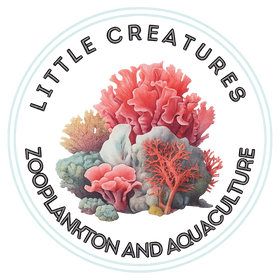Tisochrysis galbana (Isochrysis lutea): The Golden Algae Powerhouse for Aquaculture
In the world of marine aquaculture and reef systems, few phytoplankton species are as essential and versatile as Tisochrysis galbana, also known in older literature as Isochrysis lutea. This golden-brown microalga is prized for its superior nutritional profile, digestibility, and suitability across multiple aquatic species—from copepods to coral larvae and bivalve hatcheries.
What Is Tisochrysis galbana?
Tisochrysis galbana is a flagellated microalga belonging to the Haptophyta group. Originally classified as Isochrysis galbana, taxonomic revisions later split the strain into Tisochrysis galbana (T-iso) and Isochrysis lutea. Though both names are still used interchangeably in the aquaculture world, Tisochrysis galbana is the currently accepted name for the T-iso strain.
This alga is golden in colour due to the presence of fucoxanthin, a powerful antioxidant and light-harvesting pigment.
Why Is Tisochrysis galbana Important?
T. galbana is considered a “go-to” phytoplankton strain for aquaculture hatcheries and marine reef systems due to several key characteristics:
✅ High DHA Content
Tisochrysis galbana is rich in docosahexaenoic acid (DHA), an essential omega-3 fatty acid that supports the development of neural tissue and membranes in fish, crustaceans, and molluscs.
✅ Easy Digestibility
Its small cell size (~4–6 µm) and soft cell wall make it an excellent food source for delicate filter feeders like copepods, oyster larvae, clams, and scallop spat.
✅ Boosts Copepod Reproduction
Copepods fed T. galbana often show increased egg production and higher hatch rates, making it a reliable foundation for zooplankton cultures in aquaculture and live reef systems.
✅ Versatile for Multi-Species Use
This strain is used extensively in:
Bivalve hatcheries (oysters, mussels, scallops)
Shrimp larval rearing
Copepod and rotifer enrichment
Coral frag systems
Marine ornamental breeding programs
Tisochrysis vs. Other Isochrysis Strains
While “Isochrysis” is often used as a blanket term, it’s worth noting the difference between Tisochrysis galbana (T-iso) and Isochrysis sp. (clone C-ISO). The T-iso strain has higher DHA and is generally more productive and stable in culture, which is why it is often the preferred option for serious aquaculture operations.
Strain Name Current Name Key Benefit
Isochrysis lutea Tisochrysis galbana High DHA, soft cell wall
Isochrysis sp. (C-ISO) Isochrysis sp. High EPA, some DHA
Culturing Tips for Tisochrysis galbana
T. galbana is considered moderately easy to culture under clean conditions. Here’s what you need:
Temperature: 20–26°C
Salinity: 20–30 ppt
Light: Moderate to high full-spectrum lighting
Aeration: Gentle bubbling to keep cells suspended
Nutrients: Standard f/2 or Walne media
At Little Creatures Zooplankton & Aquaculture, our in-house starter cultures of Tisochrysis galbana are grown under sterile conditions to ensure purity, performance, and long shelf stability when refrigerated and handled properly.
Final Thoughts
Whether you're running a commercial hatchery, culturing copepods, or simply want to feed your reef the best live phyto available, Tisochrysis galbana (Isochrysis lutea) is a top-tier microalga with proven benefits. Its high nutritional value, ease of culture, and broad application make it a staple in any serious aquaculture or reef nutrition program.
---
Interested in culturing your own Tisochrysis?
Explore our Phytoplankton Starter Cultures Collection to get started with reliable, lab-cultured strains.
---

